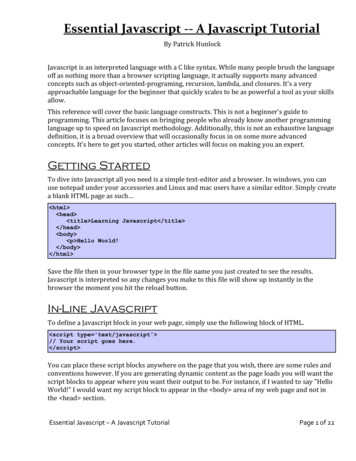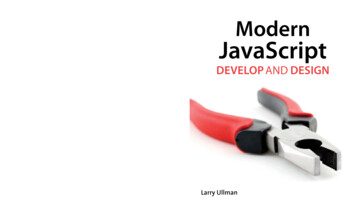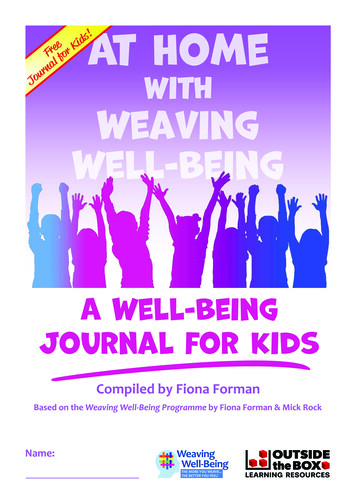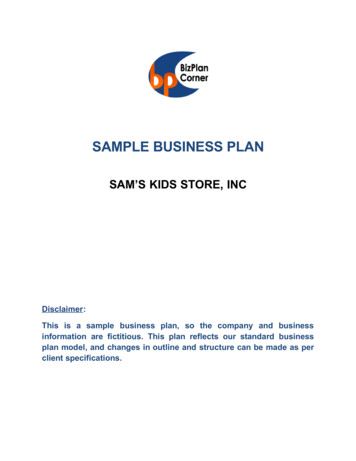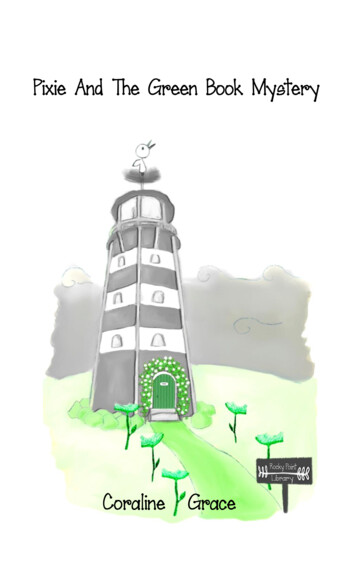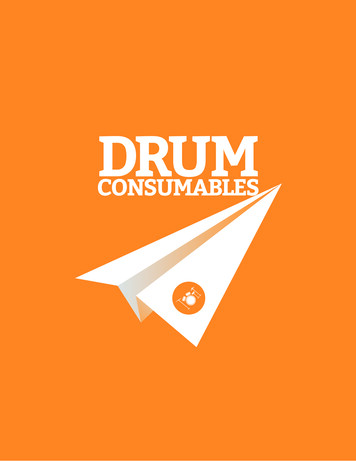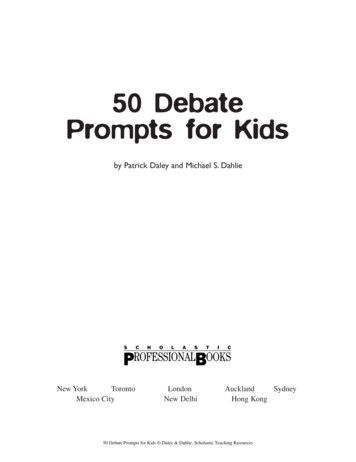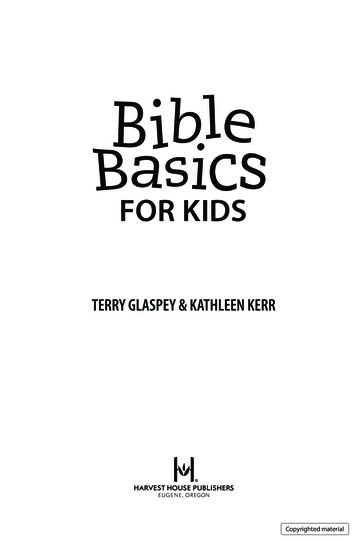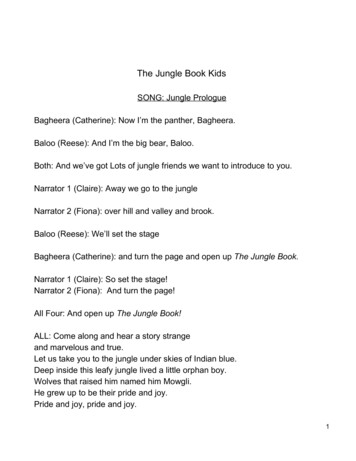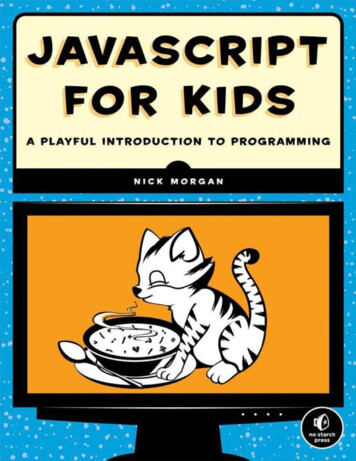
Transcription
JavaScript for Kids: A Playful Introduction toProgrammingNick MorganPublished by No Starch Press
To Philly (and Pancake)
About the AuthorNick Morgan is a frontend engineer at Twitter. He loves all programming languages but has a particularsoft spot for JavaScript. Nick lives in San Francisco (the foggy part) with his fiancée and their fluffydog, Pancake. He blogs at skilldrick.co.uk.
About the IllustratorMiran Lipovaca is the author of Learn You a Haskell for Great Good!. He enjoys boxing, playing bassguitar, and, of course, drawing. He has a fascination with dancing skeletons and the number 71, andwhen he walks through automatic doors he pretends that he’s actually opening them with his mind.
About the Technical ReviewerAngus Croll is the author of If Hemingway Wrote JavaScript, and he is obsessed with JavaScript andliterature in equal measure. He works on Twitter’s UI framework team, where he co-authored the Flightframework. He writes the influential JavaScript, JavaScript blog and speaks at conferences worldwide.He tweets at @angustweets.
AcknowledgmentsSo many thanks to my wonderful fiancée, Philly, for her encouragement and support during the past 18months. I truly couldn’t have done it without her. And thanks to Pancake, our dog, for graciouslyallowing me to use him in my code examples.Thanks to Angus, without whom I wouldn’t be here, in San Francisco, writing this book. Angus referredme to Twitter back in 2011, and then in 2013 suggested to Bill Pollock that I might be interested inwriting this book you’re holding. And to top it all, he agreed to be the technical reviewer, catching agreat number of JavaScript faux pas.Thanks to Bill Pollock, Seph Kramer, Riley Hoffman, Tyler Ortman, and everyone else at No StarchPress, who patiently guided me through the process of writing this book. Special thanks to Bill and Sephfor massaging my writing into its current form.Thanks to the young reviewers River Bradley, Damien Champ, and Alex Chu, who had some greatfeedback on the early PDFs.Finally, thanks to Miran Lipovaca. I’ve been a fan of Miran for years — his book Learn You a Haskellfor Great Good is one of my favorite programming books, and his illustrations for it are amazing.Finding out he’d be illustrating my book was like a dream come true. His pictures for this book arebetter than I could have imagined, and I’m humbled to have had the chance to work with him.
IntroductionWelcome to JavaScript for Kids! In this book, you’ll learn to program with JavaScript, the language ofthe Web. But more than that, you’ll become a programmer — someone who not only uses computersbut also controls them. Once you learn to program, you can bend computers to your will and make themdo whatever you want!JavaScript is a great programming language to learn because it’s used everywhere. Web browsers likeChrome, Firefox, and Internet Explorer all use JavaScript. With the power of JavaScript, webprogrammers can transform web pages from simple documents into full-blown interactive applicationsand games.But you’re not limited to building web pages. JavaScript can run on web servers to create wholewebsites and can even be used to control robots and other hardware!
Who Should Read This Book?This book is for anyone who wants to learn JavaScript or to start programming for the first time. Thebook is designed to be kid friendly, but it can serve as a first programming book for beginners of allages.With this book, you’ll build up your knowledge of JavaScript gradually, starting with JavaScript’ssimple data types, before moving onto complex types, control structures, and functions. After that you’lllearn how to write code that reacts when the user moves the mouse or presses a key on the keyboard.Finally, you’ll learn about the canvas element, which lets you use JavaScript to draw and animateanything you can imagine!Along the way, you’ll create a few games to stretch your programming skills and put what you’velearned to good use.
How to Read This BookFirst off, read it in order! That might sound like a silly thing to say, but lots of people want to jumpstraight into the fun stuff, like making games. But each chapter is meant to build on what was coveredin earlier chapters, so if you begin at the beginning, you’ll have an easier time when you get to thegames.Programming languages are like spoken languages: you have to learn the grammar and the vocabulary,and this takes time. The only way to improve is by writing (and reading) a lot of code. As you writemore and more JavaScript, you’ll find certain parts of the language become second nature, andeventually you’ll become a fluent writer of JavaScript.As you read, I encourage you to type out and test the code examples throughout the book. If you don’tfully understand what’s going on, try making small changes to see what effect they have. If the changesdon’t have the effect you expected, see if you can find out why.Above all, work through the “Try It Out” and Programming Challenges sections. Typing out the codethat appears in the book is a good first step, but you’ll understand programming at a deeper level whenyou start writing your own code. If you find a challenge interesting, then keep at it! Come up with yourown challenges to build even more onto the programs you’ve written.You’ll find sample solutions to the programming challenges (as well as the code files for the games andother examples) at http://nostarch.com/javascriptforkids/. Try looking at the solutions after you’vesolved a challenge, so you can compare your approach to mine. Or, if you’re stuck, you can check thesolution for hints. But remember that these are just sample solutions. There are many, many differentways to accomplish the same goal in JavaScript, so don’t worry if you end up with a completelydifferent solution from mine!If you come across a word and you don’t know what it means, check the glossary at the back of thebook. The glossary contains definitions for many of the programming terms you’ll encounter in thisbook.
What’s in this Book?Chapter 1 gives you a quick introduction to JavaScript and gets you started writing JavaScript inGoogle Chrome.Chapter 2 introduces variables and the basic data types used by JavaScript: numbers, strings, andBooleans.Chapter 3 is all about arrays, which are used to hold lists of other pieces of data.Chapter 4 is about objects, which contain pairs of keys and values.Chapter 5 is an introduction to HTML, the language used to create web pages.Chapter 6 shows you how to gain more control over your code using if statements, for loops, andother control structures.Chapter 7 puts together everything you’ve learned so far to create a simple Hangman word-guessinggame.Chapter 8 shows you how to write your own functions so you can group together and reuse blocks ofcode.Chapter 9 introduces jQuery, a tool that makes it easy to control web pages using JavaScript.Chapter 10 shows you how to use timeouts, intervals, and event handlers to make your code moreinteractive.Chapter 11 uses functions, jQuery, and event handlers to create a game called Chapter 11Chapter 12 teaches a style of programming called object-oriented programming.Chapter 13 introduces the canvas element, which allows you to draw graphics on a web page withJavaScript.Chapter 14 builds on the animation techniques you learned in Chapter 10 so you can create animationswith canvas, and Chapter 15 shows you how to control those canvas animations with the keyboard.In Chapter 16 and Chapter 17, you’ll program a complete Snake game, using everything you learnedin the previous 15 chapters!The Afterword gives you some ideas for how to learn even more about programming.The Glossary contains definitions for many of the new words you’ll encounter.
Have Fun!One last thing to remember: Have fun! Programming can be a playful and creative activity, just likedrawing or playing a game (in fact, you’ll be drawing and playing games with JavaScript a lot in thisbook). Once you get the hang of how to write code, the only limit is your imagination. Welcome to theamazing world of computer programming — I hope you have a blast!
Part I. Fundamentals
Chapter 1. What Is JavaScript?Computers are incredibly powerful machines, capable of performing amazing feats like playingcompetitive chess, serving thousands of web pages, or making millions of complex calculations in lessthan a few seconds. But deep down, computers are actually pretty dumb. Computers can only do exactlywhat we humans tell them to do. We tell computers how to behave using computer programs, which arejust sets of instructions for the computers to follow. Without programs, computers can’t do anything atall!
Meet JavaScriptEven worse, computers can’t understand English or any other spoken language. Computer programs arewritten in a programming language like JavaScript. You might not have heard of JavaScript before, butyou’ve certainly used it. The JavaScript programming language is used to write programs that run inweb pages. JavaScript can control how a web page looks or make the page respond when a viewerclicks a button or moves the mouse.Sites like Gmail, Facebook, and Twitter use JavaScript to make it easier to send email, post comments,or browse websites. For example, when you’re on Twitter reading tweets from @nostarch and you seemore tweets at the bottom of the page as you scroll down, that’s JavaScript in action.You only have to visit a couple of websites to see why JavaScript is so exciting.JavaScript lets you play music and create amazing visual effects. For example, you can fly throughan interactive music video created by HelloEnjoy for Ellie Goulding’s song “Lights”(http://lights.helloenjoy.com/), as shown in Figure 1-1.JavaScript lets you build tools for others to make their own art. Patatap (http://www.patatap.com/)is a kind of virtual “drum machine” that creates all kinds of cool noises — and cool animations togo along with them — as shown in Figure 1-2.
Figure 1-1. You control the flashing cursor in HelloEnjoy’s “Lights” music video.Figure 1-2. When you visit Patatap, try pressing a bunch of keys to make different noises!JavaScript lets you play fun games. CubeSlam (https://www.cubeslam.com/) is a 3D re-creation ofthe classic game Pong, which looks a little like air hockey. You can play against one of yourfriends or a computer-generated bear, as shown in Figure 1-3.
Figure 1-3. The CubeSlam game is programmed entirely in JavaScript!
Why Learn JavaScript?JavaScript isn’t the only programming language out there — in fact, there are literally hundreds ofprogramming languages. But there are many reasons to learn JavaScript. For one, it’s a lot easier (andmore fun) to learn than many other programming languages. But perhaps best of all, in order to writeand run JavaScript programs, all you need is a web browser like Internet Explorer, Mozilla Firefox, orGoogle Chrome. Every web browser comes with a JavaScript interpreter that understands how to readJavaScript programs.Once you’ve written a JavaScript program, you can send people a link to it, and they can run it in a webbrowser on their computer, too! (See Sharing Your Code Using JSFiddle.)
Writing Some JavaScriptLet’s write a bit of simple JavaScript in Google Chrome (http://www.google.com/chrome/). InstallChrome on your computer (if it’s not already installed), and then open it and type about:blank in theaddress bar. Now press ENTER and you’ll see a blank page, like the one in Figure 1-4.We’ll begin by coding in Chrome’s JavaScript console, which is a secret way programmers can test outshort JavaScript programs. On Microsoft Windows or Linux, hold down the CTRL and SHIFT keys andpress J. On Mac OS, hold down the COMMAND and OPTION keys and press J.If you’ve done everything correctly, you should see a blank web page and, beneath that, a blinkingcursor ( ) next to a right angle bracket ( ), as shown in Figure 1-4. That’s where you’ll writeJavaScript!NOTEThe Chrome console will color your code text; for example, the text you input will be blue, and output will be colored based on its type.In this book, we’ll use similar colors for our code text wherever we’re using the console.Figure 1-4. Google Chrome’s JavaScript consoleWhen you enter code at the cursor and press ENTER, JavaScript should run, or execute, your code anddisplay the result (if any) on the next line. For example, type this into the console:3 4;Now press ENTER. JavaScript should output the answer (7) to this simple bit of addition on the followingline:
3 4;7Well, that’s easy enough. But isn’t JavaScript more than a glorified calculator? Let’s try something else.
The Structure of a JavaScript ProgramLet’s create something a bit sillier — a JavaScript program to print a series of cat faces that look likethis: . Unlike our addition program, this JavaScript program will take up multiple lines. To type the programinto the console, you’ll have to add new lines by pressing SHIFT-ENTER at the end of each line. (If youjust press ENTER, Chrome will try to execute what you’ve written, and the program won’t work asexpected. I warned you that computers were dumb!)Type this into your browser console:// Draw as many cats as you want!var drawCats function (howManyTimes) {for (var i 0; i howManyTimes; i ) {console.log(i " . ");}};drawCats(10); // You can put any number here instead of 10.At the very end, press ENTER instead of SHIFT-ENTER. When you do that, you should see the followingoutput:0123456789 . . . . . . . . . . If you made any typos, your output might look very different or you might get an error. That’s what Imean when I say computers are dumb — even a simple piece of code must be perfect for a computer tounderstand what you want it to do!
I won’t go through exactly how this code works for now (we’ll return to this program in Chapter 8), butlet’s look at some o
programming languages. But there are many reasons to learn JavaScript. For one, it’s a lot easier (and more fun) to learn than many other programming languages. But perhaps best of all, in order to write and run JavaScript programs, all you need is a web browser like Internet Explorer, Mozilla Firefox, or Google Chrome. Every web browser comes with a JavaScript interpreter that understands how to
